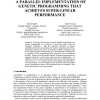Free Online Productivity Tools
i2Speak
i2Symbol
i2OCR
iTex2Img
iWeb2Print
iWeb2Shot
i2Type
iPdf2Split
iPdf2Merge
i2Bopomofo
i2Arabic
i2Style
i2Image
i2PDF
iLatex2Rtf
Sci2ools
ISCI
1998
1998
A Parallel Implementation of Genetic Programming that Achieves Super-Linear Performance
: This paper describes the successful parallel implementation of genetic programming on a network of processing nodes using the transputer architecture. With this approach, researchers of genetic algorithms and genetic programming can acquire computing power that is intermediate between the power of currently available workstations and that of supercomputers at intermediate cost. This approach is illustrated by a comparison of the computational effort required to solve a benchmark problem. Because of the decoupled character of genetic programming, our approach achieved a nearly linear speed up from parallelization. In addition, for the best choice of parameters tested, the use of subpopulations delivered a super linear speed-up in terms of the ability of the algorithm to solve the problem. Several examples are also presented where the parallel genetic programming system evolved solutions that are competitive with human performance on the same problem.
| Added | 22 Dec 2010 |
| Updated | 22 Dec 2010 |
| Type | Journal |
| Year | 1998 |
| Where | ISCI |
| Authors | David Andre, John R. Koza |
Comments (0)

